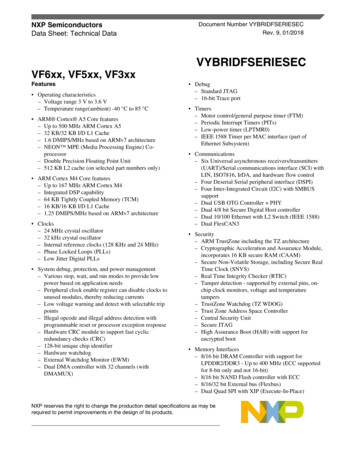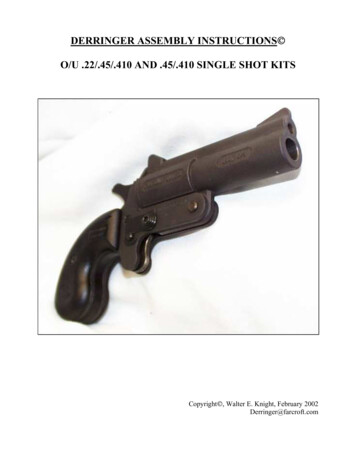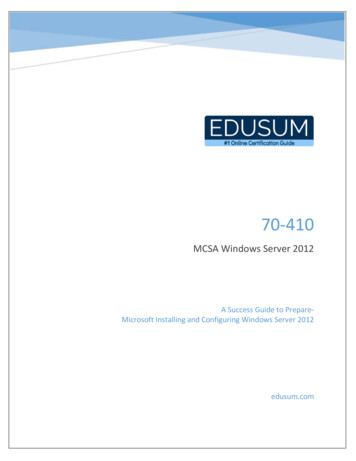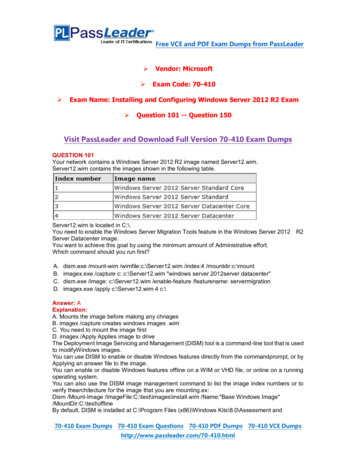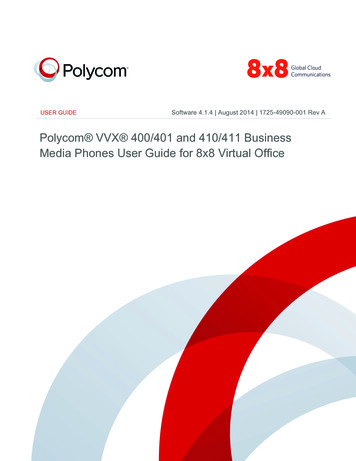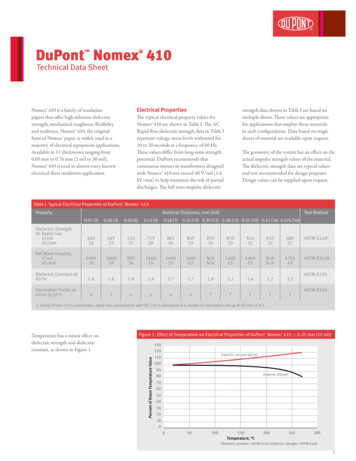
Transcription
DuPont Nomex 410 Technical Data SheetElectrical PropertiesNomex 410 is a family of insulationpapers that offer high inherent dielectricstrength, mechanical toughness, flexibilityand resilience. Nomex 410, the originalform of Nomex paper, is widely used in amajority of electrical equipment applications.Available in 11 thicknesses ranging from0.05 mm to 0.76 mm (2 mil to 30 mil),Nomex 410 is used in almost every knownelectrical sheet insulation application.strength data shown in Table I are based onmultiple sheets. These values are appropriatefor applications that employ these materialsin such configurations. Data based on singlesheets of material are available upon request.The typical electrical property values forNomex 410 are shown in Table I. The ACRapid Rise dielectric strength data in Table Irepresent voltage stress levels withstood for10 to 20 seconds at a frequency of 60 Hz.These values differ from long-term strengthpotential. DuPont recommends thatcontinuous stresses in transformers designedwith Nomex 410 not exceed 40 V/mil (1.6kV/mm) to help minimize the risk of partialdischarges. The full wave impulse dielectricThe geometry of the system has an effect on theactual impulse strength values of the material.The dielectric strength data are typical valuesand not recommended for design purposes.Design values can be supplied upon request.Table I. Typical Electrical Properties of DuPont Nomex 410 PropertyNominal Thickness, mm (mil)Test Method0.05 (2)0.08 (3)0.10 (4)0.13 (5)Dielectric StrengthAC Rapid rise,V/milkV/mm0.18 (7) 0.25 (10) 0.30 (12) 0.38 (15) 0.51 (20) 0.61 (24) 0.076 103268027ASTM D149¹Full Wave 063N/AN/A140055140055N/AN/A125049ASTM D3426Dielectric Constant at60 Hz1.61.61.82.42.72.72.93.23.43.73.7Dissipation Factor at60 Hz (x 10-³)45666677777ASTM D150ASTM D1501. Using 50-mm (2-in.) electrodes, rapid rise; corresponds with IEC 243-1 subclause 9.1, except for electrodes set-up of 50 mm (2 in.).Figure 1. Effect of Temperature on Electrical Properties of DuPont Nomex 410 — 0.25 mm (10 mil) 130120Percent of Room Temperature ValueTemperature has a minor effect ondielectric strength and dielectricconstant, as shown in Figure 1. Dielectric constant (60 Hz)1101009080Dielectric strength706050403020100050100150Temperature, C200250300Dielectric constant—ASTM D150; Dielectric strength—ASTM D1491
Figure 2. Dissipation Factor versus Temperature and Frequency of DuPont Nomex 410 —0.25 mm (10 mil) 0.0560 Hz0.042Dissipation FactorVariations in frequency up to 104 Hz haveessentially no effect on the dielectric constantof Nomex 410. The effects of temperature andfrequency on dissipation factor of dry Nomex 410 — 0.25 mm (10 mil) paper are shownin Figure 2. The 60 Hz dissipation factorsof thinner papers are essentially the same asthose for 0.25 mm (10 mil) at temperaturesup to 200 C. At higher temperaturesand frequencies, the thicker papers havesomewhat higher dissipation factors thanthose shown for 0.25 mm (10 mil) paper.10 Hz0.03310 Hz0.02410 Hz0.010.000150Temperature, C 101910181017101610151014200250300ASTM D1501013101210111010 Surface resistivityVolume resistivity0The relatively minor effects ofmoisture (humidity) on the electricalproperties of Nomex 410 — 0.25 mm(10 mil) are shown in Table II.100Figure 3. Resistivity versus Temperature of DuPont Nomex 410 — 0.25 mm (10 mil)Volume Resistivity, ohm.cm orSurface Resistivity, ohm/squareSurface and volume resistivities of dryNomex 410 — 0.25 mm (10 mil) paperare shown in Figure 3 as functions oftemperature. The corresponding valuesfor other thicknesses of Nomex 410 arevery similar.5050100150Temperature, C200250300ASTM D257Table II. Humidity Effects on Electrical Properties of DuPont Nomex 410 — 0.25 mm (10 mil) PropertyRelative Humidity, % Typical ValueTest MethodOven Dry5096Dielectric Strength,V/milkV/mm85033.584533.278030.7ASTM D149¹Dielectric Constantat 60 Hzat 1 kHz2.52.32.72.63.23.1ASTM D150Dissipation Factorat 60 Hz (x 10-³)at 1 kHz (x 10-³)6136141125ASTM D150Volume Resistivity,ohm.cm6 x 10162 x 10162 x 1014ASTM D2571. Using 50-mm (2-in.) electrodes, rapid rise; corresponds with IEC 60243-1 subclause 9.1 except for electrodeset-up of 50 mm (2 in.).2
Like other organic insulating materials, Nomex paper is gradually eroded under attack bypartial discharges. Partial discharge intensityis a function of voltage stress, which, in turn,depends almost entirely on design parameterssuch as spacing between circuit elements,smooth vs. sharp contours, etc. Although coronadoes not occur during normal operation ofproperly designed electrical equipment, anydevice may be subject to occasional overvoltagesthat produce brief corona discharges; andit is important that the insulation not failprematurely under these conditions. The voltageendurance (time to failure under corona attack)of Nomex 410 is superior to other commonlyused organic insulations and even comparesfavorably with some inorganic compositions,as shown in Figure 4. These data were obtainedin all cases on single layers of 0.25 mm (10 mil)materials at room temperature, 50% relativehumidity, and 360 Hz frequency. Times tofailure at 50–60 Hz are approximately 6 to 7times as long as indicated.Figure 4. Voltage Endurance of Various Insulating Materials — Single-Layer DuPont Nomex 410 —0.25 mm (10 mil) 2420Stress in kV/mm16Nomex 818 Paper12Glass/Mica splittings/Glass(with silicone)Polyester(mat/film/mat)–100% epoxyimpregnation8Polyester FilmNomex 410 Paper4010 010 110 2Time for 5th of 10 Failures (hours)10 3This data is provided for comparative purposes only and should not be used as design values.104ASTM D2275 360 HzMechanical PropertiesThe typical mechanical property valuesfor Nomex 410 are shown in Table III.Table III. Typical Mechanical Properties of DuPont Nomex 410 PropertyNominal Thickness, mm (mil)Test Method0.18 (7) 0.25 (10) 0.30 (12) 0.38 (15) 0.51 (20) 0.61 (24) 0.076 (30)0.05 (2)0.08 (3)0.10 (4)0.13 (5)Typical TM D374¹Basis Weight, g/m²416488115174249310395549692839ASTM nsile Strength, 10374728500816592ASTM D828Elongation, %MDXD10712912916132015221823182216231821162117ASTM D828Elmendorf Tear, .016.714.324.8N/AN/AN/AN/ATAPPI 414Initial Tear Strength, 3193ASTM D1004²Shrinkage at 300 C, 0.10.00.00.00.00.00.0Density, g/ccMD Machine Direction; XD Cross Direction1. Method D; using 17 N/cm².2. D ata presented for initial tear strength is listed in the direction of the sample per ASTM D1004. The tear is 90 degrees to sample direction; hence, for papers with a higherreported machine direction initial tear strength, the paper will be tougher to tear in the cross direction.3
The dimensions of bone-dry Nomex 410exposed to 95% relative humidity (RH)conditions will increase at most 1% in themachine direction and 2% in the crossdirection (due to moisture absorption). Thisswelling is largely reversible when the paperis re-dried. The rate of change in dimensionswill depend, of course, on paper thicknessand configuration (e.g., individual sheetsversus tightly wound rolls). Variations inenvironmental humidity will usually producedimensional changes that will be less than 1%.However, even small dimensional changes—especially if they are non-uniform—can causeor accentuate non-flatness (e.g., sag, puckers,etc.) in the sheet, which can cause problemsin critical operations like laminating orcreping. Therefore, Nomex paper intendedfor these applications should be kept sealedin its protective polyethylene wrapper tomaintain uniform moisture content untiljust before use. For more information on theeffects of moisture on Nomex insulationand how to appropriately protect therolls, request our moisture brochure. 140Tensile elongation (MD)130120Percent of Room Temperature ValueThe effects of moisture (humidity) ontensile strength and elongation are shown inFigure 6. Like elongation, the tear strengthand toughness of Nomex 410 are alsoimproved at higher moisture contents.Figure 5. Effect of Temperature on Mechanical Properties of DuPont Nomex 410 —0.25 mm (10 mil)110100908070Tensile strength (MD)6050403020100050100MD Machine Direction150Temperature, C200250300ASTM D828Figure 6. Effect of Moisture on Mechanical Properties of DuPont Nomex 410 — 0.25 mm (10 mil) 140120Tensile elongation (MD)Percent of Bone-dry ValueThe effects of high temperatures on tensilestrength and elongation are illustrated inFigure 5. Nomex sheet structures also retaingood mechanical properties at very lowtemperatures. At the boiling point of liquidnitrogen (minus 196 C or 77 K) the tensilestrength of Nomex 410 — 0.25 mm (10 mil)paper exceeds its room temperature valueby 30% to 60% (depending on direction),while elongation to break is still greater than3% (better than most inorganic materials atroom temperature). This allows Nomex 410to work well in cryogenic applications.10080Tensile strength (MD)604020001020MD Machine Direction3040506070Relative Humidity, %8090100110ASTM D8284
Figure 7. Useful Life versus Temperature for DuPont Nomex 410 — 0.25 mm (10 mil) 10 6Aging Time, Hr to 300 V/mil (12 kV/mm)Dielectric StrengthThe effects of long-time exposure ofNomex 410 — 0.25 mm (10 mil) to hightemperature on important electrical andmechanical properties are shown in Figures 7and 8. These Arrhenius plots of aging behaviorare the basis for the recognition of Nomex paper as a 220 C insulation by UnderwritersLaboratories and have been utilized foralmost 50 years in commercial applications.These curves can also be extrapolated tohigher temperatures. Measurements show,for example, that Nomex 410 will maintain300 V/mil (12 kV/mm) dielectric strengthfor several hours at 400 C, which is theperformance predicted by the Arrhenius plot.105Log time 1048262 – 11.44 C 27310 310 2100140180220Temperature, C260300340380ASTM D1830 (curved electrodes)Figure 8. Useful Life versus Temperature for DuPont Nomex 410 — 0.25 mm (10 mil) 10 6Aging Time, Hr to 50% of Initial Strengthin Machine DirectionThermal Properties105104Log time 7461– 10.40 C 27310 310 2100140180220Temperature, C260300340380Tested per UL7465
Figure 9. Thermal Conductivity versus Temperature for DuPont Nomex 410 — 0.25 mm (10 mil) 260240Thermal Conductivity, mWatt/meter KThe thermal conductivity of Nomex 410— 0.25 mm (10 mil) paper is shown inFigure 9. These values are similar to thosefor cellulosic papers and, as with mostmaterials, are primarily determined by specificgravity (density). Therefore, thinner gradesof Nomex 410 will have slightly lowerconductivity and thicker grades will havehigher conductivities, as is seen in Table IV.The total system construction mayaffect the overall thermal conductivity;therefore, care should be taken in applyingindividual sheet data to actual situations.For example, two sheet insulations withidentical thermal conductivities may havequite different effects on heat transfer froma coil due to the differences in stiffnessor winding tension, which affect thespacing between the insulation mperature, C250300ASTM E1530Table IV. Thermal Conductivity of DuPont Nomex 410 The compatibility of Nomex papers andpressboards with virtually all classes ofelectrical varnishes and adhesives (polyimides,silicones, epoxies, polyesters, acrylics,phenolics, synthetic rubbers, etc.), as wellas with other components of electricalequipment, is demonstrated by the manyUL-recognized systems comprising Nomex ,including use in commercial applications foralmost 50 years. Nomex papers are also fullycompatible (and in commercial use) withtransformer fluids (mineral and silicone oilsand other synthetics) and with lubricatingoils and refrigerants used in hermetic systems.Common industrial solvents (alcohols,ketones, acetone, toluene, xylene) have a slightsoftening and swelling effect on Nomex 410,similar to that of water. These effects aremainly reversible when the solvent is removed.The Limiting Oxygen Index (LOI) ofNomex 410 at room temperature rangesbetween 27% and 32% (depending onthickness and density); at 220 C, it rangesbetween 22% and 25%. Materials with LOIabove 20.8% (ambient air) will not supportcombustion. Nomex 410 must be heatedbetween 240 C and 350 C (again dependingon thickness) before its LOI declines belowthe flammability threshold. The LOI data forNomex 410 — 0.25 mm (10 mil) is shownin Figure 10.Nominal 150.51200.7630Density, g/cc0.720.810.830.880.950.961.021.061.08Thermal Conductivity,¹mWatt/meter K1031141171231431391491571751. All data taken at 150 CASTM E1530Figure 10. Limiting Oxygen Index (LOI) for DuPont Nomex 410 — 0.25 mm (10 mil) 35Limiting Oxygen Index, %Chemical Stability 302520150100200Temperature, C300400ASTM D28636
Radiation ResistanceThe outstanding radiation resistance of Nomex paper has led to its use in critical controlequipment for nuclear power installations.and polyester mat of the same thickness,100% epoxy-impregnated, crumbled after800 megarads, or 8 Mgy). Similar results wereobtained on exposure to gamma radiation.The effect of 6400 megarads (64 Mgy) of 2 MeVbeta radiation on the mechanical and electricalproperties of Nomex 410 is shown in Table V.(By comparison, a laminate of polyester filmTable V. Radiation Resistance of DuPont Nomex 410 — 0.25 mm (10 mil) to 2 MeV Electrons (Beta Rays) PropertyDose, MgyTest Method01248163264Tensile Strength, % of STM D828Elongation, % of originalMDXD1001008992929196887682604736271816A
ASTM D149¹ Full Wave Impulse, V/mil . Dielectric constant—ASTM D150; Dielectric strength—ASTM D149 Percent of Room Temperature Value Temperature, C Dielectric strength Temperature has a minor effect on Figure 1. Effect of Temperature on Electrical Properties of DuPont Nomex 410 — 0.25 mm (10 mil) dielectric strength and dielectric constant, as shown in Figure 1. 2 0.00 0.01 0 .
